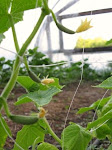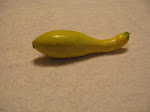
Lakes and Valley CSA news Week 7
Delivering to PR and DL August 11. Dilworth and Fargo August 14, 2008
Anne’s cell phone 218-252-5858
In your veggie boxes this week:
Raspberries
Jade and Provider Green beans
new crop baby lettuce with edible flowers
Cheriette Radishes
Blue Wind Broccoli
Early Jersey Wakefield cone-shaped or Alcosa Savoy round cabbage
Ailsa Craig sweet onions
Green and yellow zucchini, yellow crookneck and patty pan summer squashes
Diva and Tyria hoophouse cucumbers
Cilantro and Basil
Cutting celery (dry for winter meals)
Red and gold cherry tomatoes, plus some slicers
Bell or pointed sweet pepper, as we can
Sweet baby Jane or Rainbow early carrots
Swiss chard and kale greens
Cauliflower or beets or bag of snow and sugar snap peas
Calendula flowers (dry petals for sunny winter garnishes)
The garden is overflowing with abundances of produce, enthusiasm and energy. Member Carmen Nodsle and her son Calvin came on Monday to help wash, sort, bag and box veggies. And they delivered the DL share boxes on their way home. Thank you so much! You were great help and stupendous company.
Thank you, as well, Fargo members, who help me carry boxes up to Brigitte’s porch. I really appreciate the help, especially as the boxes get heavier and my time between loading the truck and departure has shrunk to twenty minutes.
It takes thirty-five woman hours twice a week to pick and pack CSA deliveries at this stage of the season. Eight hours are spent delivering the share boxes. Chicken chores of grinding feed, feeding, watering, moving houses, egg gathering and washing add another seven hours per week. Garden weeding, watering and successive planting need thirty-five or more hours. Top those off with tidy-time lawn mowing around and through the raspberries and veggie plots, and….you get the picture. CSA gardening is a full time job for four people.
Several of you have told me that you have friends eager to sign up for the 2009 veggie season. This is very exciting, for we have decided it is time to add a packing shed onto the garden tool building. We laid a foundation of cement blocks ten years ago, when I was stuck on the crazy notion of opening a seasonal restaurant featuring biodynamic produce grown on site. I’d read about such establishments in Gourmet and Bon Appetit magazines and was convinced it could work here. Plus, I’d get a real dinner when Dewane and I worked until dark.
That dream never came to fruition, but it evolved into the CSA. Same good food, great contributing cooks. Jennifer Geraedts is one. She offers, “An incredibly easy, yummy way to eat zucchini and squash. Slice it and fry it in maple syrup (nothing else in the pan but maple syrup).”
Dewane and a buddy have been harvesting big Norway pines that were blown down during the tornado in July. Howard will saw them into lumber specifically for the packing shed. We have a local crew lined up next year to erect a 36x 40 foot structure that will shelter us on harvest days from wind and rain, sun and sleet. It will be big enough to add a walk-in cooler someday, and have a gravel floor with a drain for the hundreds of gallons of cooling rinse water we use each week.
Midheaven Farms (our farm) will take out a bank loan for this improvement, and the CSA will pay back the loan over two years. This is how we started the CSA in 2001, by building the tool shed, putting in the big well and purchasing the water reel, hoses and sprinklers.
Which brings me back to your new member referrals. Affording agricultural improvements without mortgaging everything you own is like moving a house. Carefully and systematically, you raise the number of square feet under production, secure and train co-workers, and determine where you want to go. Then you add CSA member shares to balance those decisions, and voilá! Sustainable agriculture.
The overall goal Dewane and I hold is to donate fifteen acres of garden and woods surrounding the garden to the Yggdrasil Land Trust. The land trust would hold the land in perpetuity for CSA food production. Workers and members of the CSA would lease the land for a nominal fee and keep going what we started seven years ago.
Our plan for the rest of our farm is to put a conservation easement on the land that guarantees organic food production on it. Our land is best suited for pasture and hay for beef or dairy cattle, small grains for egg and meat chickens, vegetables and small fruits.
On August 20th, a group of Minnesota legislators will visit the CSA garden as part of a fact-finding tour on local food production organized by Rep. Brita Sailer. I would like to present them with a list of legislative suggestions. I’d love your input. Email me.
So far I have:
1. Funding for low interest loans for infrastructure (processing equipment, coolers, tools, fencing, etc) for CSA and direct local food production and processing.
2. Funding for wind and solar generated electricity for cold season greenhouse production of fresh produce.
3. State purchase of working ag land development rights through full or matching funding.
A new flower in your bag of mesclun is Mexican Mint Marigold. Tiny, pretty golden yellow flowers top aromatic leaves, which are a substitute for French tarragon. We’ll still give you peppery nasturtiums, cucumber-like borage, radishy radishes, and carotene-rich orange calendula. I love it!
Cucumbers
“He has been eight years upon a project for extracting sunbeams out of cucumbers, which were to be put into phials hermetically sealed, and let out to warm the air in raw inclement summers.” Jonathan Swift (Gulliver’s Travels)
In the 1600’s physicians treated fever victims by having them lie on a bed of sliced cucumbers. Hence the expression, “cool as a cucumber.” As for eating cucumbers, French scholar Louis Lémery, in Treatise of All Sorts Of Foods, recommends cucumbers only for “young Persons of hot and bilious Constitutions.”
The Ancient Sumerians are credited with the earliest human civilization. What we know about them is preserved in the Gilgamesh, a Sumerian cuneiform that is the first known written legend and tells of a great flood in which man was saved by building an ark. In the Gilgamesh, it is mentioned that Sumerian foods included wild cucumbers. The cucumber is believed to be native to the great Indian center of plant origins, which lies between the northern part of the Bay of Bengal and the Himalayas. The cucumber have never been found wild anywhere, but species closely related to it have been found wild in that region of India.
From there the cucumber spread widely. The cucumber was mentioned in the Bible and was grown in North Africa, Italy, Greece, Asia Minor and other areas at the beginning of the Christian era. The Roman emperor Tiberius demanded cucumbers daily, which required farmers to use artificial methods of growing the hot weather crop, including transporting plants around in wheelbarrows to catch the sun’s rays. Charlemagne had cucumbers growing in his gardens in ninth-century France. They were known in England in the early 1300’s,, but the art of growing them was apparently lost there as a result of a long period of war and turmoil. Cucumbers were reintroduced from the Continent some 250 years later.
Columbus planted cucumbers in Haiti in 1494, and possibly on other islands. Explorers who touched Virginia in 1584 mentioned cucumbers. Presumably the Natives’ knowledge of cucumbers had spread after its introduction by Spaniards far to the south.
Cucumbers were grown in Virginia in 1609 and in Massachusetts in 1629.
The Garden-Fresh Vegetable Cookbook, by Andrea Chesman
Freezing Broccoli
Boil water in a large pot. Fill a sink or big bowl with cold water, as cold as you have. Cut Broccoli into bite-sized florets, splitting thick stems. Put into the boiling water and blanch for 3 minutes. Remove immediately and plunge into the cold water. When cool, pack into baggies, press to remove air, and twist tie. Put in freezer and clap for joy. You have several winter meals already made.
The gist of freezing vegetables is to halt enzyme activity in the vegetable by blanching. You can tell when it’s heated enough by the color. Broccoli turns dark green. Then you want to stop the blanching to avoid over-cooking the vegetable. So you cool rapidly. The bag and pop in the freezer. The best results come from being quick. Quick from the garden to the stove, quick from stove to sink. Quick from sink to freezer. Taste and nutrition superior.
Small batches don’t take a long time to process. You can eat some of each week’s broccoli and freeze the rest. With a little determination, your CSA season can last all winter.
Cucumbers in sour cream aka Finnish kurkusalaatti
8 cups thinly sliced cucumbers (CSA cucumbers don’t need to be peeled)
2 teaspoons salt
1 cup sour cream
3 Tablespoons white vinegar
3 Tablespoons chopped fresh dill
1 teaspoon sugar
freshly ground pepper
Combine cucumbers and salt in a colander and toss to coat. Set aside to drain for 30 minutes. Transfer cucumbers to a clean kitchen towel and pat dry.
Mix together remaining ingredients. Add in cucumbers and toss gently. Serve immediately.
---------------------
SUMMER VEGETABLE STEW
---------------------
6 oz. green beans or yellow wax beans
Salted water
2 med. sized tomatoes
2 garlic cloves
1-2 tbsp. mixed fresh herbs such as marjoram, basil, thyme, savory
Narrow strip of lemon rind
1 sm. red or yellow onion, quartered, thinly sliced
crosswise
1 each small red & yellow bell pepper, thinly sliced
2 green or golden patty pan squash, quartered, thinly sliced
2 zucchini halved, sliced
5-6 mushrooms, thinly sliced or quartered
2-3 tbsp. virgin olive oil
About 1/2 c. water
3 tbsp. unsalted butter
Juice of 1/2 lemon, or more to taste
Freshly ground pepper
1. Use tender, small beans and leave them whole or, if
you're using longer ones, cut them into pieces about 3
inches long. Heat a generous amount of salted water to a
boil, add the beans and cook until just tender. Remove them
with a scoop, rinse them briefly, and set them aside.
2. Plunge the tomatoes into the pot for 10 seconds. Remove
the core and slip off the peel. Cut them in half and gently
squeeze out the seeds. Cut into nice-looking pieces.
3. Chop the garlic with half the herbs and the lemon rind
and prepare all the other vegetables.
4. Gently warm the olive oil in a large, wide pan and add
the onion and half the garlic-herb mixture. Cook slowly
over medium-low heat, stirring frequently, for about 3
minutes. Add the peppers, squash and mushrooms. Add half
the water, season lightly with salt, and cook until the
vegetables have begun to soften, about 5 minutes. If the
liquid evaporates, add more water in small increments just
to cover the bottom of the pan.
5. Add the green beans and tomatoes and continue cooking
until they are warm; then stir in the butter, the remaining
herbs and lemon juice. Raise the heat a little to help melt
the butter and shake the pan bake and forth to combine all
the juices. Taste for salt. Add more lemon juice, if
desired and pepper to taste. There should be an herbaceous
sauce at the end, the tender (but not overly so)
vegetables, and a soft perfume of garlic and herbs.






